Speaking Up and Speaking Out
On the third Friday evening of every month, the Chicago Shambhala center transforms from a peaceful meditation center to a throbbing hub of music and expression. Gone are the smartly dressed middle class adults, and in come teenagers in sweatpants, Nikes, and baseball caps. Gone are the white majority. There are mainly African Americans, Puerto Ricans, Mexicans, and other people of color at this venue. They are here for an evening down in the basement, where the space is dark except for the spotlight and the stage. The silence and quiet of the center is gone, pierced by the loud proclamations of rap, song, and dance.
It’s my first time experiencing a Speak Up Chicago open mic night and I am not comfortable.
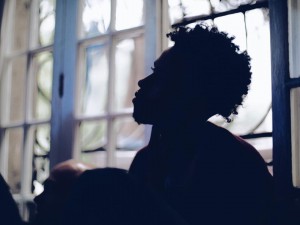 It’s the noise. It’s the darkness. Everything is so different from how things are normally run at Shambhala Chicago. The young people here might not even know this is a meditation center. They’re here for a stage where they can express themselves with no judgement, no matter how twisted and tortured and real the issues they bring up are. As an intern of Shambhala, I, like many others who come to the center, came for the meditation. I came for the beautiful flower arrangements and the pure and tranquil atmosphere. I am all about finding peace and bravery in daily life. And now I’m putting my hands over my ears because the speakers are so loud. I hate staying up late during the night.
It’s the noise. It’s the darkness. Everything is so different from how things are normally run at Shambhala Chicago. The young people here might not even know this is a meditation center. They’re here for a stage where they can express themselves with no judgement, no matter how twisted and tortured and real the issues they bring up are. As an intern of Shambhala, I, like many others who come to the center, came for the meditation. I came for the beautiful flower arrangements and the pure and tranquil atmosphere. I am all about finding peace and bravery in daily life. And now I’m putting my hands over my ears because the speakers are so loud. I hate staying up late during the night.
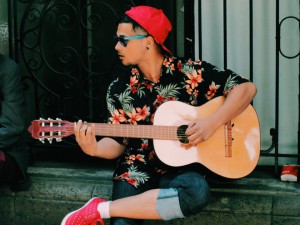 But Speak Up Chicago is more than an open mic night. Despite the title. It is simply an open invitation for the youth in Chicago to find support in whatever venture they’d like to explore, whatever creative thing it may be. To tell the tale from the beginning, it starts with the Sakyong. Under his inspiration to “open the flower outwards”, Shambhala Chicago began to interact with the outside community, beginning with a few conferences and trainings with mindfulness meditation. After the conference “Imagining Peace”, a student named Joshua Lazu, who was a part of the conference, came up to Aarti Tejuja, the current director of Social Engagement at Chicago Shambhala, and asked if he could start an open mic night at the center. Aarti said yes.
But Speak Up Chicago is more than an open mic night. Despite the title. It is simply an open invitation for the youth in Chicago to find support in whatever venture they’d like to explore, whatever creative thing it may be. To tell the tale from the beginning, it starts with the Sakyong. Under his inspiration to “open the flower outwards”, Shambhala Chicago began to interact with the outside community, beginning with a few conferences and trainings with mindfulness meditation. After the conference “Imagining Peace”, a student named Joshua Lazu, who was a part of the conference, came up to Aarti Tejuja, the current director of Social Engagement at Chicago Shambhala, and asked if he could start an open mic night at the center. Aarti said yes.
Around the same time several young people (including myself), started dropping in and telling her they were interested in working for social justice or the open mic night. Encountering many different challenges along the way, we began to form a core group. We have traveled this strange journey of life together, supporting and helping each other along the way.
Speak Up Chicago seems to have generated a lot of buzz. It’s true, this group is definitely different. But sometimes I and others at Speak Up worry about becoming the poster children of Shambhala. We represent a new vein from the white hippies that eventually became Chogyam Trungpa’s students. We’re a group of people of color who are simply hanging out, becoming a close knit family, sharing our sorrows and joys. Because beyond what we do in this vision of engagement and working for peace in the face of violence, there is a primordial aspect of family in this group. We share each other’s homes, lives, and activities, going to barbecues and birthday parties.
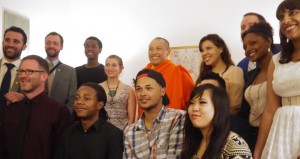 Family. That’s an aspect that Shambhala seems to lack, in fact. It seems many come to Shambhala from other religious traditions, where they felt like there wasn’t a genuine spirituality that they could relate to. Shambhala offers something special, fostering bravery and gentleness. But after the retreats are done, we go back to our lives. We return to our homes and come back to the center for the next class or the next meditation session. But how much do we really offer up to share? Everyone knows that acquaintances only share the good parts, the pretty parts of their lives. True family shares everything, the darkness and the light.
Family. That’s an aspect that Shambhala seems to lack, in fact. It seems many come to Shambhala from other religious traditions, where they felt like there wasn’t a genuine spirituality that they could relate to. Shambhala offers something special, fostering bravery and gentleness. But after the retreats are done, we go back to our lives. We return to our homes and come back to the center for the next class or the next meditation session. But how much do we really offer up to share? Everyone knows that acquaintances only share the good parts, the pretty parts of their lives. True family shares everything, the darkness and the light.
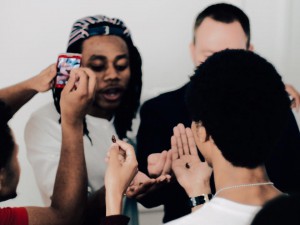 Within Speak Up, we offer up something that expands the vision of what Shambhala can be. Shambhala can become more than a meditation center. There is an energy that magnetizes the space, where we continue to challenge the older, more senior folks in creating new ventures, new horizons to reach for. We’re looking for people from Englewood and other violent neighborhoods to interact with people from downtown and Hyde Park. We’ve attended the Sakyong’s “Making Peace Possible” conference, and have traveled to Mexico to attend the Ziji Summit as the largest represented group of young people in Shambhala. We’re planning to do a retreat at the Windhorse center in Wisconsin.
Within Speak Up, we offer up something that expands the vision of what Shambhala can be. Shambhala can become more than a meditation center. There is an energy that magnetizes the space, where we continue to challenge the older, more senior folks in creating new ventures, new horizons to reach for. We’re looking for people from Englewood and other violent neighborhoods to interact with people from downtown and Hyde Park. We’ve attended the Sakyong’s “Making Peace Possible” conference, and have traveled to Mexico to attend the Ziji Summit as the largest represented group of young people in Shambhala. We’re planning to do a retreat at the Windhorse center in Wisconsin.
We come from a different part of the city, not the clean, well-educated, protected areas, but the places people whisper about, where some of us have endured traumas that people have only heard of and never have experienced. Some of us suffer from a continuous lack of support and financial means, contributing to the high probability of not graduating from school and being involved with crime and drug abuse. Many of us are scarred by the systematic racism that does not allow people of color and lower economic means to thrive. But we are Shambhala as well, an enlightened society that arises from true reality.
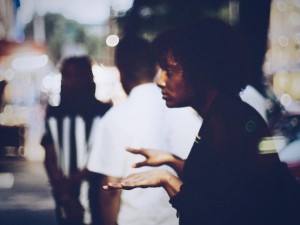 What is Shambhala exactly then? What are we? These questions come up in the face of our existence. Because the fact remains obvious: Shambhala is dominated by middle class, college educated white people. Why is it so hard to attract people of color or poor people? Even I, a fairly whitewashed, middle class Asian American college student, feel uncomfortable in the Shambhala Level classes because I am constantly surrounded by white people. And I am committed to and deeply inspired by the Shambhala vision. There is nothing I want more than to be a true warrior. And yet, I constantly struggle with the feeling of discomfort on being the only person of color in the room while attending Shambhala activities. Why do I feel like an alien, like an outsider?
What is Shambhala exactly then? What are we? These questions come up in the face of our existence. Because the fact remains obvious: Shambhala is dominated by middle class, college educated white people. Why is it so hard to attract people of color or poor people? Even I, a fairly whitewashed, middle class Asian American college student, feel uncomfortable in the Shambhala Level classes because I am constantly surrounded by white people. And I am committed to and deeply inspired by the Shambhala vision. There is nothing I want more than to be a true warrior. And yet, I constantly struggle with the feeling of discomfort on being the only person of color in the room while attending Shambhala activities. Why do I feel like an alien, like an outsider?
What exactly attracts only white people to Shambhala? Maybe because it’s so squeaky clean and articulate, and offers an image of Eastern wisdom that Westerners long for. But what if that’s problematic? On my return from the Ziji Collective retreat in Mexico, I realized that there was an inordinate number of Harvard graduates and professors at the conference! Is the very culture and language that we have adopted too sophisticated and wordy for the average high school dropout? What if people speak in different ways? How can we foster diversity in Shambhala? It seems our existence forces us to expand the vision of what Shambhala means, because it means different things to different people now. Speak Up Chicago is a testament to a different kind of Shambhala.
Sai Wei is the intern of Social Engagement at the Chicago Shambhala center. She is currently studying at Shimer College with an emphasis on philosophy.

